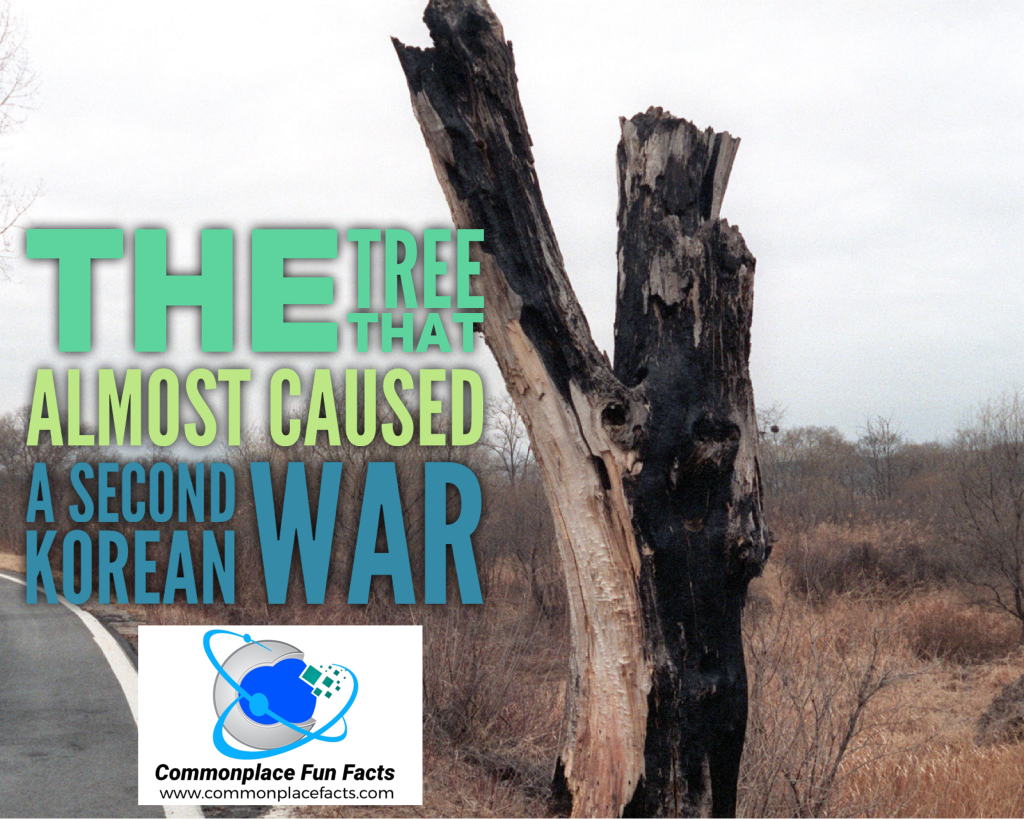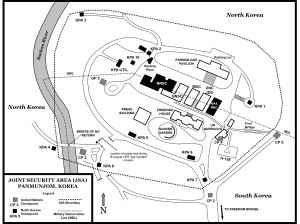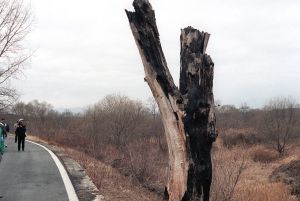
Nations have fought wars over seemingly insignificant objects. There was the bloody war about a bucket, the revolution that began with a dispute about an unpaid wig, and the big kerfuffle over a disputed pig, Despite those lessons from history, it may surprise you to learn about a poplar tree that triggered a massive military mobilization and could have led to World War III.
An Uneasy Truce
The Korean War (1950-1953) came to an uncomfortable and uncertain cessation of hostilities with the establishment of the Joint Security Area (JSA) and the Korean Demilitarized Zone (DMZ). The only place only the heavily-guarded border where North and South Korean soldiers stand face-to-face, the JSA was the point for diplomatic and military negotiations from the end of active fighting until 1991.
The northernmost operations of the United Nations Command (UNC) in the JSA included Checkpoint 3 (CP3) and Observation Post 5 (OP5). Because of a 100-foot (30-meter) poplar tree, the line of sight between CP3 and OP5 was obstructed. This was particularly problematic because CP3 was situated near the Military Demarcation Line that separated the two countries. There had been several attempts by the North Korean army to abduct United Nations personnel from CP3 and drag them across the bridge into North Korean territory. By cutting off the view from OP5, the large poplar tree led to CP3 being dubbed “The Loneliest Outpost in the World.”

Confrontations with North Korea continued and culminated with a group of North Korean soldiers holding a group of United States soldiers at gunpoint. Company Commander Captain Arthur Bonifas led a unit to bring the Americans back to safety. That incident was the straw that broke the camel’s back. Something had to be done to provide additional support for OP3. The most obvious solution was to do something about that tree.
Tree Trimming and First Blood
On August 18, 1976, Bonifas and his South Korean Army counterpart, led a team of soldiers with the mission of trimming the tree. The mission had been scheduled with North Korean representatives. Not expecting any conflict, the two captains led the team without sidearms. This was also to comply with the agreement that only five armed officers and 30 armed enlisted personnel could be in the JSA at one time.
No sooner did the tree-trimming operation begin before it was interrupted by about fifteen North Korean soldiers. They were led by Senior Lt. Pak Chul, nicknamed “Lt. Bulldog” because of his reputation for being confrontational. Pak demanded that the soldiers immediately stop their work on the tree. He said the tree could not be trimmed because “Kim Il-Sung personally planted it and nourished it and it’s growing under his supervision.”
Bonifas had his orders and commanded the detail to continue its work, giving no further attention to Pak. Pak was not accustomed to being ignored. He dispatched a messenger across the bridge, who shortly returned with approximately 20 North Korean soldiers. They were armed with clubs and crowbars. Pak again ordered the tree trimmers to stop their work. When Bonifas again ignored the instructions, Pak removed his watch, carefully wrapped it in a handkerchief, placed it in his pocket, and shouted “Kill the [expletive deleted]!”
With sudden fury, the North Korean soldiers descended on the tree trimmers. Using their crowbars and clubs, as well as the axes dropped by the tree trimmers, they stopped the work on the tree with extreme force. Bonifas was bludgeoned to death by at least five North Korean soldiers. Lt. Mark Barrett died while being transported to a hospital in Seoul. All but one of the members of the tree-trimming detail sustained wounds in the attack.
While US and UN personnel tried to make sense of the incident, the North Korean media started airing reports. According to the state-controlled media account:
“Around 10:45 a.m. today, the American imperialist aggressors sent in 14 hoodlums with axes into the Joint Security Area to cut the trees on their own accord, although such a work should be mutually consented beforehand. Four persons from our side went to the spot to warn them not to continue the work without our consent. Against our persuasion, they attacked our guards en masse and committed a serious provocative act of beating our men, wielding murderous weapons and depending on the fact that they outnumbered us. Our guards could not but resort to self-defense measures under the circumstances of this reckless provocation.”
Later analysis by the CIA suggested that the incident had been pre-planned by the North Korean government. One reason to believe this is that within four hours of the attack, North Korean leader Kim Jong-il, who was in Sri Lanka at the time, presented a prepared document that described the incident in great detail. He introduced a resolution to the Conference of Non-Aligned Nations to condemn the United States and to call upon the US to withdraw fully from the Korean peninsula.
The United States raised its readiness level for its forces in Korea to DEFCON 3 while it assessed its future options. President Gerald Ford convened his national security team. For three days, tensions escalated, and the world wondered whether the ill-positioned poplar tree would be the spark that would turn the Cold War into World War III.
Operation Paul Bunyan
Ford decided on a response that was carefully designed to show force while avoiding full-blown escalation. The plan, named Operation Paul Bunyan, in honor of the mythical lumberjack, would deal decisively with the offending tree and make sure it would cause no further problems.
On August 21, at 7:00 a.m., Operation Paul Bunyan was implemented. Without prior warning to North Korea, two eight-man teams of engineers from the 2nd Engineer Battalion, 2nd Infantry Division assaulted the tree. The engineers were armed with chainsaws. They were supported by two security platoons of 30 men each, armed with pistols and axe handles. One platoon was charged with securing the northern entrance to the JSA via the Bridge of No Return. The other platoon had responsibility for securing the southern edge of the area. At the same time, other units took up positions to secure and defend nearby areas in case the situation escalated out of control.
A team of South Korean special forces, 64 men strong, accompanied the engineers. These men were trained in Tae Kwon Do and were armed with clubs. Hidden in their vehicles were M-16 rifles and M-79 grenade launchers. Once in position, they deployed sandbags and distributed the firearms. Several men strapped Claymore mines to their chests. They guarded the bridge, defying their North Korean counterparts to cross and engage them.
Twenty utility helicopters and 7 Cobra attack helicopters took up position behind the ground troops for support. Behind them, flying as an undisguised reminder of US firepower, were B-52 Stratofortresses, F-4 Phantom IIs, and South Korean F-5 Freedom Fighters. The F-111 bombers of the 366th Tactical Fighter Squadron and the aircraft carrier Midway task force went to alert, ready to deploy at a moment’s notice.
If all of this weren’t enough, U.S. and South Korean forces near the DMZ went on high alert. This included the Second Battalion, 71st Air Defense Regiment, armed with HAWK missiles. Military command issued orders to bases near the DMZ to prepare for a North Korean military response. Should a retaliatory invasion occur, base commanders had their orders to demolish the bases, rather than allow them to fall into enemy hands.
In anticipation of a second Korean War, the Pentagon sent an additional 12,000 troops to Korea, including 1,800 Marines who were redeployed from Okinawa.
In short, U.S. and South Korean forces went to battle readiness alert in preparation for dealing with the offending tree. An intelligence analyst who monitored the tactical communications of North Korea’s military reported that the rapid and massive escalation of force “blew their… minds.”

When Operation Paul Bunyan got underway, engineers pulled their vehicles up to the tree and stood on the top of the vehicles to commence cutting it down. North Korea reacted by sending 150-200 soldiers, armed with machine guns and rifles. They were startled when they saw the helicopters and jets that were standing by. After a brief time of remaining on their transport buses, the North Koreans disembarked and set up two-man machine gun posts. They held their fire, however, and watched helpless for the 42 minutes that it took to bring the offending tree down.
Their task completed, the engineers intentionally left a 20-foot (6-meter) stump as a visible reminder of what happened.
Aftermath
Despite the concerns that Operation Paul Bunyan would escalate into a new war, the DMZ returned to its uneasy peace. The only reported North Korean response was a few shots fired at a U.S. helicopter later that day, but no one was injured.
The United Nations Command demanded North Korea “punish those involved and make adequate reparations to the families of those killed and injured.” In response, Kim Il-Sung expressed regret at the incident but avoided taking responsibility. He said, “It was a good thing that no big incident occurred at Panmunjom for a long period. However, it is regretful that an incident occurred in the Joint Security Area, Panmunjom this time. An effort must be made so that such incidents may not recur in the future. For this purpose both sides should make efforts. We urge your side to prevent the provocation. Our side will never provoke first, but take self-defensive measures only when provocation occurs. This is our consistent stand.” Although coming in far short of demands, it was the first somewhat-conciliatory expression from North Korea since the armistice.
In honor of Captain Bonifas, the Joint Security Area’s Advance Camp was renamed Camp Bonifas. The tree stump remained standing until 1987 when it was cut down and replaced with a monument dedicated to the memory of the men who were killed there.
The axe that was allegedly used in the incident is on display in the North Korea Peace Museum.
William J. Livsey was the Commanding General of the Eighth United States Army in South Korea from 1984 to 1987. He carried a swagger stick made from the poplar tree. The swagger stick was passed on to his successor.
The Great Tootsie Roll Battle of the Korean War
On Veteran’s Day we honor and celebrate those who have served their country in the armed forces. These individuals are known for bravery, selflessness, commitment to duty, and innovation in the face of challenges. Few moments in history illustrate all of these characteristics better than the Battle of Chosin Reservoir, when soldiers used a tasty…
Keep readingSeven Score and Three Years Later, The Last of the Civil War Widows Passes Away
The last widow of a veteran of the US Civil War died on August 17, 2008, at the age of 93. Maudie Cecilia Acklin was 19 years old in 1934 when she married William M. Cantrell, aged 86. Cantrell served in the Confederate States Army, having enlisted at the age of 16. The marriage ended…
Keep readingTales from the Great and Glorious Pig War of 1859
History is replete with stories of wars that were fought over the love of a woman, the quest for power, and ideological differences. In 1859 two of the world’s greatest military powers prepared for battle over a pig. The San Juan Islands, located north of Seattle, Washington, were part of a disputed territory claimed by…
Keep readingDiscover more from Commonplace Fun Facts
Subscribe to get the latest posts to your email.
Categories: Geography, Government, History, Military and Warfare, Presidents, US History



